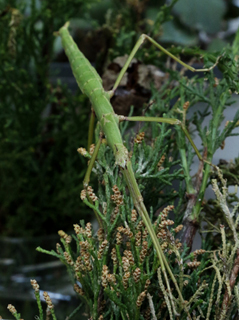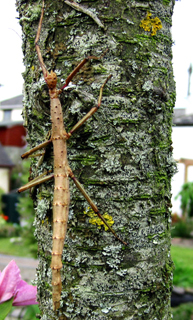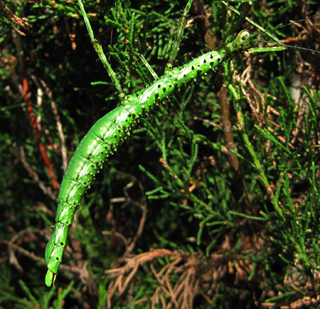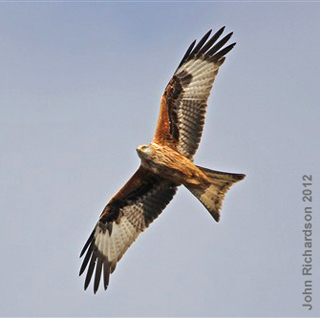 Aliens are in our midst and we do not even know it, for they are “phasmids,” rarely seen, like phantoms or ghosts. Their biggest concentration in the UK is in Cornwall, with a speciality in St Mawes.
Aliens are in our midst and we do not even know it, for they are “phasmids,” rarely seen, like phantoms or ghosts. Their biggest concentration in the UK is in Cornwall, with a speciality in St Mawes.
They are creatures who do not need males to procreate as the females are “parthenogenic”. But what are they really? Where did they come from? How do they survive? They are Stick Insects!
 They are thought to have arrived in Cornwall, as a result of the Victorian and early 20th century plant hunters’ expeditions, that brought back southern hemisphere plants and trees for the large estate gardens of southwest England, a number of which we have in south Cornwall and the Scillies. The maritime climate and the warm summers here meant that the survival rate of the cargo was high, including anything attached to leaves or rootballs. It is thought that the stick insects arrive from New Zealand, probably as eggs on tree ferns.
They are thought to have arrived in Cornwall, as a result of the Victorian and early 20th century plant hunters’ expeditions, that brought back southern hemisphere plants and trees for the large estate gardens of southwest England, a number of which we have in south Cornwall and the Scillies. The maritime climate and the warm summers here meant that the survival rate of the cargo was high, including anything attached to leaves or rootballs. It is thought that the stick insects arrive from New Zealand, probably as eggs on tree ferns.
Stick insects’ lives are short, usually lasting about a year. Adults live on leaves in the canopy of trees, particularly those of eucalyptus, but here they also live on conifers such as leylandii, as well as privet and bramble. The life cycle starts with adults ejecting hundreds of tiny seed like eggs from the treetops. These eggs fall to the ground. Some survive and eventually hatch. The young stick insect grows, moulting and eating its own skin several times as it gradually climbs up into the canopy. After a few months in the treetops the eggs are laid and drop to the ground, completing the cycle.
 There are three varieties of Stick insect, their colour either green or brown. The commonest we have is the Unarmed, then the Prickly, which is the St Mawes speciality, and finally the Smooth on Tresco. Unlike other non-native species classed as invasive, stick insects do not appear to harm the UK environment, or affect the status of other species. This may be partly due to their natural requirement for a warm climate, such that a limited cohort survive our winters here, controlling their numbers.
There are three varieties of Stick insect, their colour either green or brown. The commonest we have is the Unarmed, then the Prickly, which is the St Mawes speciality, and finally the Smooth on Tresco. Unlike other non-native species classed as invasive, stick insects do not appear to harm the UK environment, or affect the status of other species. This may be partly due to their natural requirement for a warm climate, such that a limited cohort survive our winters here, controlling their numbers.
If you see a stick insect, the Phasmid Study Group would love you to record your sightings here.
Upcoming Wild Roseland Walks and Talks – dates for your diary
Note that all events are free but a small donation of £3 would be welcomed.
 Dawn Chorus Walk
Dawn Chorus Walk
Sunday 6th May 2018, 5am, Messack.
Join us on international Dawn Chorus Day for around 2 hours to listen to the incredible sounds of songbirds at Messack. A circular walk of under 2 miles. Numbers limited to 15. Sorry, no dogs as sheep and lambs are on site.
Contact David Hall for more details and to request a place.
01872 501429 or hallruan@aol.com
 Other Wild Roseland Active Events coming up soon in 2018 Watch out for our summertime outdoor activities, including:
Other Wild Roseland Active Events coming up soon in 2018 Watch out for our summertime outdoor activities, including:
- Moth Trap survey
- Seaweed survey
- Farm visit
- Bat Recognition evening
- Fungus foray.
Details will appear in the Roseland Magazine, wildroseland.org, our Facebook page, and our monthly e-letter.
Thank you for all the support you have given to Wild Roseland by attending our winter programme of talks, or in any other way.
What to look out for this month in the Roseland
 Red Kites (Milvus milvus). Every year, Red Kites (usually non-breeding juveniles) go on a mass wander that takes them from the eastern side of the UK, down through the West Country and all the way to the end of Cornwall. Red Kites are distinguishable from similarly-sized Buzzards by their reddish-brown body, angled wings and deeply forked tail – Learn more from the RSPB here.
Red Kites (Milvus milvus). Every year, Red Kites (usually non-breeding juveniles) go on a mass wander that takes them from the eastern side of the UK, down through the West Country and all the way to the end of Cornwall. Red Kites are distinguishable from similarly-sized Buzzards by their reddish-brown body, angled wings and deeply forked tail – Learn more from the RSPB here.
As they do not usually cross the water at Lands End, they simply turn round and fly back to the east. Occasionally they are joined by Black Kites (Milvus migrans) that have crossed over from Europe. So keep a look-up, and if you see one, share it with us on our Facebook page. If you get a photo – even better!
Contributors:
David Hall, Sarah Vandome
Red Kite image by John Richardson for RSPB, 2012.
Edited by Sarah Vandome.
References and links
Buglife (2018) Stick Insects, available online: https://www.buglife.org.uk/bugs-and-habitats/stick-insects
Lee, M. (2013) The Naturalised British Stick insects, a phasmid study group paper, available online: http://phasmidstudygroup.org/phasmids/uk-phasmid-sighting
Lee, M. (2004) The British & Irish stick-insects. Online document available from: http://erccis.org.uk/sites/default/files/docs/Species{c8c3b3d140ed11cb7662417ff7b2dc686ffa9c2daf0848ac14f76e68f36d0c20}20Guide{c8c3b3d140ed11cb7662417ff7b2dc686ffa9c2daf0848ac14f76e68f36d0c20}20-{c8c3b3d140ed11cb7662417ff7b2dc686ffa9c2daf0848ac14f76e68f36d0c20}20Stick{c8c3b3d140ed11cb7662417ff7b2dc686ffa9c2daf0848ac14f76e68f36d0c20}20Insect.pdf
Enjoy more Roseland wildlife and landscapes – visit Sarah Vandome’s Heart of Roseland Facebook feature:
https://www.facebook.com/HeartOfRoseland?ref=hl
Wild Roseland is on Facebook.
Wild Roseland is a group of volunteers who care passionately about looking after the nature and landscape of the Roseland peninsula in south Cornwall. Through a number of initiatives and projects, the aim is to inspire and enhance the conservation of this special place for all.

